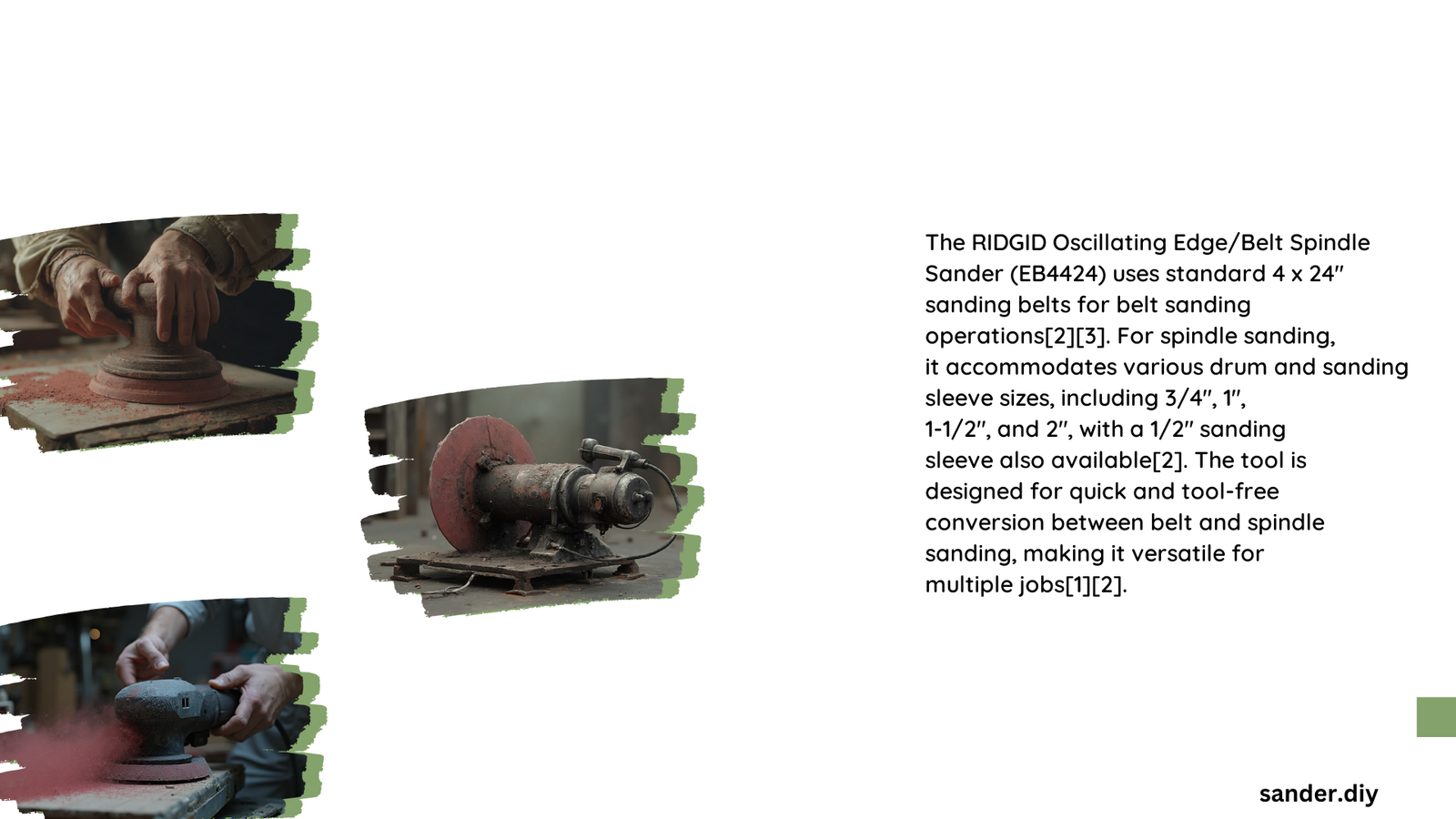The Ridgid spindle sander is a versatile tool that requires specific belts for optimal performance. This guide explores the belt specifications, including size, material, and compatibility. We’ll delve into installation techniques, common challenges, and cost considerations to help you make informed decisions about your Ridgid spindle sander belts.
What Are the Exact Belt Specifications for a Ridgid Spindle Sander?
The Ridgid oscillating edge belt/spindle sander uses belts with the following specifications:
- Size: 4 inches wide by 24 inches long
- Material: Typically made from abrasive materials such as aluminum oxide or silicon carbide
- Grit: Available in various grit sizes to suit different sanding needs
These specifications ensure compatibility and optimal performance with the Ridgid spindle sander model.
How Do You Choose the Right Belt Material and Grit?

Selecting the appropriate belt material and grit is crucial for achieving the desired sanding results. Here’s a guide to help you choose:
- Aluminum Oxide Belts:
- Best for: General-purpose sanding on wood, metal, and plastic
- Durability: Long-lasting and resistant to heat buildup
-
Grit range: Available in coarse to fine grits
-
Silicon Carbide Belts:
- Best for: Sanding hard materials like glass, stone, or ceramics
- Characteristics: Sharper and more brittle than aluminum oxide
- Grit range: Typically available in finer grits for smooth finishes
When selecting grit size, consider the following:
| Grit Range | Application |
|---|---|
| 40-60 | Coarse sanding, material removal |
| 80-120 | Medium sanding, surface preparation |
| 150-220 | Fine sanding, finishing |
| 240+ | Very fine sanding, polishing |
Choose a grit progression based on your project requirements, starting with coarser grits for material removal and progressing to finer grits for smooth finishes.
What Are the Compatible Belt Models for Ridgid Spindle Sanders?
While Ridgid produces belts specifically for their spindle sanders, any belt that matches the 4 x 24 inch size specification will be compatible. Here are some options:
- Ridgid brand belts (recommended for optimal performance)
- Third-party manufacturers offering 4 x 24 inch belts
- Universal sanding belts in the correct size
When selecting compatible belts, consider factors such as:
- Material quality
- Grit consistency
- Durability
- Price point
It’s advisable to have a variety of belts on hand to tackle different sanding tasks efficiently.
How Do You Install and Use Belts on a Ridgid Spindle Sander?
Proper installation and use of belts are crucial for the sander’s performance and longevity. Follow these steps:
- Belt Installation:
- Locate the quick-release belt tensioning lever
- Slide the lever left to release tension
- Place the new belt over the rollers, ensuring correct orientation
-
Slide the lever right to apply tension
-
Belt Alignment:
- Turn on the sander
- Observe the belt’s movement
-
Use the tracking knob to center the belt on the assembly
-
Belt Tension Adjustment:
- Ensure the belt is taut but not overly tight
- Check for any slack or looseness
-
Adjust tension as needed using the quick-release lever
-
Safe Operation:
- Wear appropriate safety gear (eye protection, dust mask)
- Keep hands away from moving parts
- Apply even pressure when sanding
- Allow the sander to do the work; avoid excessive force
What Are Common Challenges with Ridgid Spindle Sander Belts?
Users may encounter several issues when working with Ridgid spindle sander belts:
- Improper Belt Tension:
- Symptom: Uneven sanding or belt slippage
-
Solution: Adjust tension using the quick-release lever
-
Misaligned Belt:
- Symptom: Belt runs off-center or unevenly
-
Solution: Use the tracking knob to center the belt
-
Worn-out Belts:
- Symptom: Reduced sanding efficiency, visible wear
-
Solution: Replace belts regularly, inspect before each use
-
Heat Buildup:
- Symptom: Burning smell, discoloration of workpiece
-
Solution: Use appropriate grit, avoid excessive pressure
-
Dust Accumulation:
- Symptom: Reduced sanding effectiveness, clogged belt
- Solution: Use dust collection system, clean belt regularly
What Are the Cost Considerations for Ridgid Spindle Sander Belts?
Understanding the cost implications of Ridgid spindle sander belts helps in budgeting and maintenance planning:
- Price Range: $10 to $30 per belt, depending on quality and grit
- Quantity Recommendations:
- 2-3 belts of each grit size for continuous work
- Minimum of 3 grit sizes (coarse, medium, fine) for versatility
Cost-Saving Tips:
1. Buy in bulk for discounts
2. Consider multi-grit packs
3. Properly maintain belts to extend lifespan
4. Compare prices between Ridgid brand and compatible alternatives
Long-Term Considerations:
– Factor in replacement costs when budgeting for projects
– Invest in higher quality belts for demanding or frequent use
– Balance cost with performance needs for optimal value
By understanding what belts a Ridgid spindle sander takes and how to select, install, and maintain them, you can ensure optimal performance and longevity of your sanding equipment. Regular inspection, proper tension adjustment, and timely replacement of worn belts will contribute to efficient and effective sanding results across various projects.
